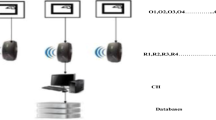Abstract
Radio frequency identification (RFID) helps automatic identification of objects using radio waves. This is not a new technology instead decades old and has been used during the World War II, when it was used by allied ground forces to track German bombers. It is a technology for wireless communication between a reader and a transponder/tag. This technology permits the transfer of data to the most diverse objects without the need for physical contact and uses intelligent barcodes to track items and have been successfully applied in military, security, healthcare, real time location tracking, vehicle identification and other areas. This paper is based on applications of RFID technology with eMaintenance cloud for railway system to analyze and visualize data of trains for the cost effective maintenance planning. Further, cloud computing is an emerging research area that can be utilised for acquiring an effective and efficient information logistics. Specifically, the widespread use of RFID will enable wagons to be tracked leading to better resource utilization, lower freight costs, and better maintenance. Therefore, it helps to provide greater control of the train carriages, making it easier to plan resources. However, RFID is a powerful tool that can help to improve industry proficiency, implementing this technology is not easy. Furthermore, operating RFID systems can be a challenging process. Thus, this paper is based on the application of RFID in the context of railway operation.







Similar content being viewed by others
References
Burnell J (2006) What is RFID middleware and where is it needed? http://www.rfidupdate.com/articles/index.php?Id=1176. Accessed June 2013
Candell O, Karim R, Parida A (2011) Development of information system for e-maintenance solutions within the aerospace industry. Int J Performability Eng 7(6):583–592
Garfinkel S, Rosenberg B (2005) RFID application, security, and privacy. USA, ISBN: 0-321-29096-8
Haseloff S (2005) Context awareness in information logistics. Doctoral Thesis. Elektrotechnik und Informatik der Technischen Universität, Berlin
Heuwinkel K, Deiters W, Konigsmann T, Loffeler T (2003) Information logistics and wearable computing. Proceedings of the 23rd International Conference on Distributed Computing System, p 283–288
Ilie-Zudor E, Kemeny Z, Egri P, Monostori L (2006) The RFID technology and its current applications. Proceedings of the Modern Information Technology in the Innovation Processes of Industrial Enterprises, p 29–36
Iung B, Crespo Marquez A (2006) Editorial: special issue on eMaintenance. J Comput Ind 57(6):473–606
Kajko-Mattsson M, Karim R, Mirjamd A (2011) Essential components of e-maintenance. Int J Performability Eng 7(6):555–571
Karim R (2008) A service-oriented approach to eMaintenance of complex technical systems. Doctoral Thesis, Luleå University of Technology, Luleå
Karim R, Candell O, Söderholm P (2009) Emaintenance and information logistics: aspects of content format. J Qual Maint Eng 15(3):308–324
Koc M, Lee J (2001) A system framework for next-generation e-maintenance systems. Proceedings of the 2nd International Symposium on Environmentally Conscious Design and Inverse Manufacturing
Muller A, Marquez AC, Iung B (2008) On the concept of e-maintenance: review and current research. J Reliab Eng Syst Saf 93(8):1165–1187
Mutigwe C, Aghdasi F (2007) Research trends in RFID technology. INTERIM 6(1):68–82
Parida A, Phanse K, Kumar U (2004) An integrated approach to design and development of eMaintenance system. Proceedings of VETOMAC-3 and ACSIM-2004, p 1141–1147
Remy B (2013) Canadian national railway cuts chassis cycle time nearly in half using RFID. http://www.motorolasolutions.com/web/Business/Product%20Lines/Symbol/Symbol%20RFID/_Documents/StaticFiles/CN%20Railway_CS_0807.pdf. Accessed July 2013
RFID Solutions (2013) RFID solutions for railway industry. http://railway.gaorfid.com. Accessed July 2013
RFID Standards (2013) GS1 RFID/EPC standards for railways. http://www.gs1.eu/?content=1008. Accessed July 2013
RFID Systems (2013) Radio frequency identification (RFID) systems. http://epic.org/privacy/rfid/#history. Accessed July 2013
Tsang A (2002) Strategic dimension of maintenance management. J Qual Maint Eng 8(1):07–39
Turcu C (2011) In: Turcu C (ed) Deploying RFID—challenges, solutions, and open issues. InTech, Rijeka, ISBN 978-953-307-380-4
Xiaoqiang Z, Manos T (2011) Applications of fast-moving RFID tags in high-speed railway systems. Int J Eng Bus Manag 3(1):27–31
Author information
Authors and Affiliations
Corresponding author
Rights and permissions
About this article
Cite this article
Kour, R., Karim, R., Parida, A. et al. Applications of radio frequency identification (RFID) technology with eMaintenance cloud for railway system. Int J Syst Assur Eng Manag 5, 99–106 (2014). https://doi.org/10.1007/s13198-013-0196-z
Received:
Published:
Issue Date:
DOI: https://doi.org/10.1007/s13198-013-0196-z




